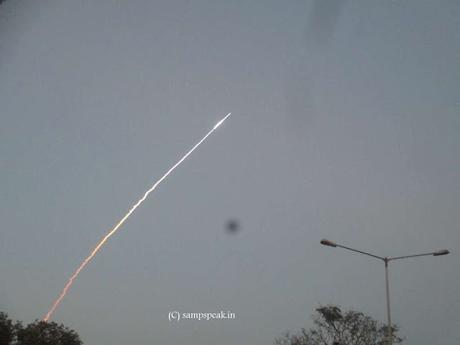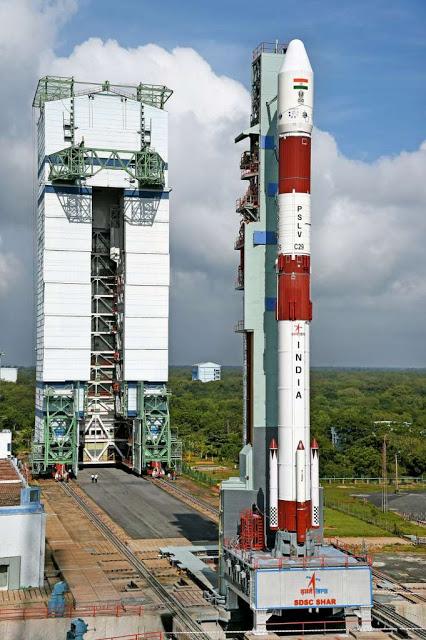
It is yet another achievement of Indian Space Research Organisation in adding another country to its client list for commercial satellite launches after Polar Satellite Launch Vehicle (PSLV-C29) put in orbit six Singapore satellites today. A core-alone version of the PSLV (without solid strap-ons) took off from the first launch pad of Satish Dhawan Space Centre in Sriharikota, 100km north of Chennai, at 6pm on Wednesday. A little more than 18 minutes later, the rocket ejected the 400kg TeLEOS-1 into a 555km circular orbit. The other five satellites (two micro satellites and one nano satellite) were put in orbit within another three minutes before the fourth stage of the rocket re-started to move away from the satellites before.
Soon after the last of the satellites was put in the orbit, ISRO chairman A S Kiran Kumar announced the mission a success. It was PSLV 32nd flight, and the 31st consecutively successful one. The workhorse rocket has become so reliable that the chairman said Isro would now have almost monthly launches of PSLV. It was a remarkable achievement amidst concerns of weather conditions. "There was rainfall over the region ... despite the weather conditions, the team has been able to pull off a perfect launch," he said. Of the six satellites, TeLEOS-1 is the primary satellite weighing 400 kg whereas the other five are co-passenger satellites. In what is a grand milestone, ISRO has completed 50 launches from the Satellite Launching Station in Sriharikota Range, known as SHAR, with the successful launch of the Polar Satellite Launch Vehicle PSLV-C29. Situated on an island off Sullurupeta - a small town in Nellore district, of the state Andhra Pradesh the launch centre located at Sriharikota, was named as Satish Dhawan Space Centre, SHAR in September 2002, in memory of Professor Satish Dhawan, who was Chairman of ISRO from 1972 to 1984. photo credit : isro.org
As scheduled, at 6.00
pm, the 44.4 metres tall PSLV rocket with a vehicle lift off mass of 227 tonne
took off from the first launch pad &
completed the launch of all the satellites in its intended orbit in 21 minutes
into its flight. After injecting all the satellites, the mission also carried
out a major experiment to restart the fourth stage engine. Success of this
would give ISRO the mission flexibility to plan different orbital missions in a
single launch vehicle missions. An official said that the restart was
successful and the multiple burn fuel engine might be used in the PSLV-C35, to
launch satellite in two different orbits.
The Polar Satellite
Launch Vehicle, commonly known by its abbreviation PSLV, is an expendable
launch system developed and operated by the Indian Space Research Organisation
(ISRO). It was developed to allow India to launch its Indian Remote Sensing
(IRS) satellites into Sun synchronous orbits, a service that was, until the
advent of the PSLV, commercially available only from Russia. PSLV can also
launch small size satellites into geostationary transfer orbit (GTO). As of
2015 the PSLV has launched 93 satellites (36 Indian and 57 foreign satellites)
into a variety of orbits. Some notable
payloads launched by PSLV include India's first lunar probe Chandrayaan-1 ,
India's first interplanetary mission Mangalyaan (Mars orbiter) and India's first
space observatory Astrosat.
I was fortunate to witness from
Sriharikota range [thanks to SR Ragunathan] the successful launch of GSLV mark
III with Crew module on 18th Dec 2014. At 09.30 am, ISRO successfully tested its most
powerful satellite launch vehicle that can put heavier payloads into
space. It was an experiment to test the vehicle's atmospheric stability and
its design. It was powered by two engines while a third is under development.
Another
milestone and a great day for India ~ kudos to our Space scientists.
With regards – S.
Sampathkumar
photo credit : isro.org
As scheduled, at 6.00
pm, the 44.4 metres tall PSLV rocket with a vehicle lift off mass of 227 tonne
took off from the first launch pad &
completed the launch of all the satellites in its intended orbit in 21 minutes
into its flight. After injecting all the satellites, the mission also carried
out a major experiment to restart the fourth stage engine. Success of this
would give ISRO the mission flexibility to plan different orbital missions in a
single launch vehicle missions. An official said that the restart was
successful and the multiple burn fuel engine might be used in the PSLV-C35, to
launch satellite in two different orbits.
The Polar Satellite
Launch Vehicle, commonly known by its abbreviation PSLV, is an expendable
launch system developed and operated by the Indian Space Research Organisation
(ISRO). It was developed to allow India to launch its Indian Remote Sensing
(IRS) satellites into Sun synchronous orbits, a service that was, until the
advent of the PSLV, commercially available only from Russia. PSLV can also
launch small size satellites into geostationary transfer orbit (GTO). As of
2015 the PSLV has launched 93 satellites (36 Indian and 57 foreign satellites)
into a variety of orbits. Some notable
payloads launched by PSLV include India's first lunar probe Chandrayaan-1 ,
India's first interplanetary mission Mangalyaan (Mars orbiter) and India's first
space observatory Astrosat.
I was fortunate to witness from
Sriharikota range [thanks to SR Ragunathan] the successful launch of GSLV mark
III with Crew module on 18th Dec 2014. At 09.30 am, ISRO successfully tested its most
powerful satellite launch vehicle that can put heavier payloads into
space. It was an experiment to test the vehicle's atmospheric stability and
its design. It was powered by two engines while a third is under development.
Another
milestone and a great day for India ~ kudos to our Space scientists.
With regards – S.
Sampathkumar
16th Dec 2015.

